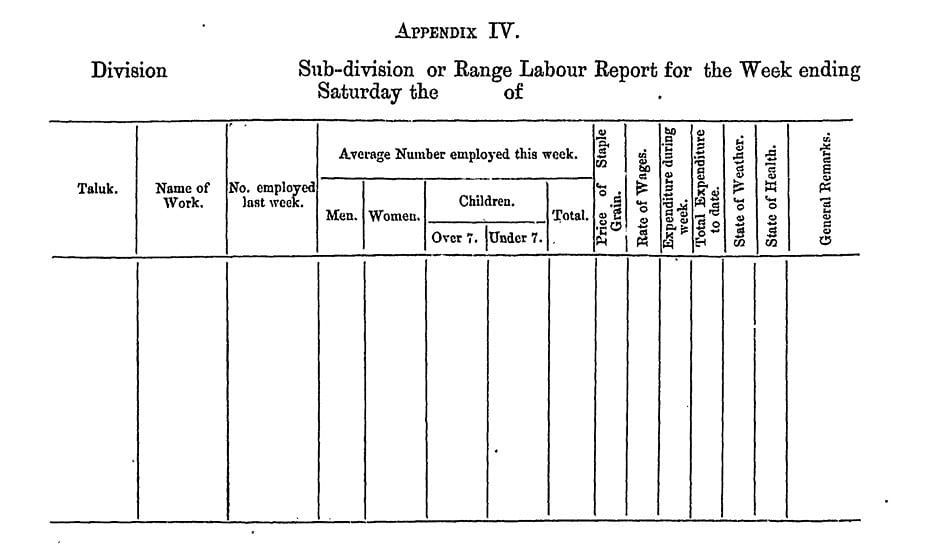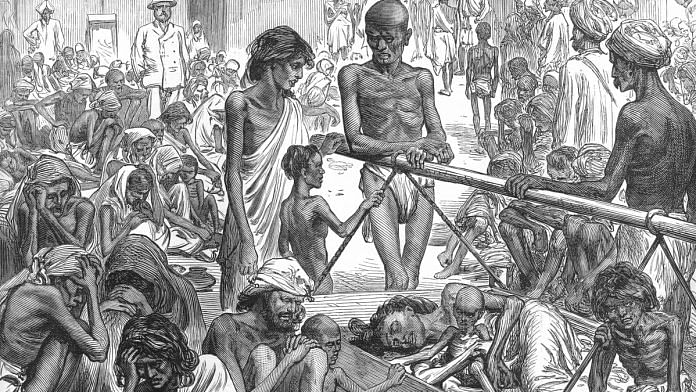It is well known that Winston Churchill’s policies to reroute grain from Bengal to the war fronts impoverished the entire province in a few months. And 2.5 to 3.8 million people perished. But famines in colonial India were not just the result of global exigencies of a shocking war. Famine management revealed two other principles of colonialism as it played out in the late 19th century: The colonial government’s impetus to maintain free trade, and the reliance on caste and gender-based hierarchies to perpetuate economic prosperity.
Famines were the glaring example of these two principles, especially in the last decades of the nineteenth century. Around 12 to 29 million people died in famines between 1876 and 1902. In western India for example, historian David Washbrook says that commercial cotton production in the Deccan led to a “progressive crisis in agricultural production”. While the production of cash crops made many Indian merchants into capitalists, the same overhaul of the economy had a devastating impact on the countryside in the late 19th century. Famines were not a glitch in colonialism but an inevitable feature.
Let us focus on the ‘Great Famine of 1876-1878’. Starting in 1876, drought afflicted Madras, Bombay, Mysore, and Hyderabad for two years. In the second year, parts of Central and United Provinces were affected. According to the Imperial Gazetteer of India (1907), 58.5 million people were affected by the famine. Official estimates marked the death toll at 5.2 million. More recent estimates mark it at 8 million.
In 1878, the Famine Commission was created to plan relief, and prevent future famines. First, the Commission did not believe that the government had the authority to control the prices of food as that would interfere with free trade. This policy of non-interference was an earnest corollary of experiments with economic liberalism. Second, the Commission enshrined the principle of the labouring body: One had to work to procure food. Charity should be minimal, and only to those found incapable of work. The task of the government was not to directly provide nourishment to its population, but to give them work so that the people can continue to be consumers.
The government of India set up relief camps. In these camps, famine relief was given to those who would work in large-scale constructions under the Public Works Department, and receive a subsistence wage, or “famine wage”. When we think of large-scale constructions such as canals and roads constructed under the British government, we must think of famine relief workers who worked under these subsistence wages. Small-scale work under rural administration such as the construction of wells was also part of famine relief.
If we see famine management as an economic enterprise run by a big land revenue conglomerate, the British government in India, you can see how capitalism took shape in India.
Also read: When it comes to British rule, rich, powerful Indians were complicit every step of the way
The economy of thrift: Famine wage
As Madras witnessed the harshest impact of the drought, Richard Temple was appointed the Special Famine Commissioner. The British parliament tasked him with ensuring that the colonial State did not spend too much on relief. He started an experiment. “The present rate of wages is fixed at two annas per diem (per day) for an adult, and proportionately lower for women and children,” Temple declared. This rate was based upon the supposition that it will purchase one pound of grain, a quantity that was deemed essential for a man while at work.

Figure 1: Figure: an idealised worksheet at relief camps, demonstrated to the British parliament by T.G. Hewlett, Sanitary Commissioner of Bombay Presidency
Colonialism was, however, not a singular voice, and scientific experts within the colonial machinery were horrified at the reduced amount of food. Critics of Temple pointed out that the food experiment undermined the science of nutrition. Surgeon-Major Cornish, the Sanitary Commissioner of Madras, mobilised evidence from his own research in prisons in Madras to argue that people normally consumed 24 to 48 ounces a day. Temple’s diet would barely keep a man alive while at rest, let alone when exhausted from work. Temple criticised Cornish, claiming that Indians lived for centuries without “abstract scientific theories of public health”.
Temple’s experiment failed, as Madras saw mass deaths. Journalists, missionaries in Europe and the US, and even members of the Indian government cried about the dangers. Journalist William Digby asked his British readers if the British would be alright with such a policy of thrift. Digby asked: “Are we, like the Indian Government, to say, “We won’t give you ordinary wages. No, not even if you do extra work. But when screwing you down, we don’t intend that any one is to die of starvation.” Indians who were affected by the famine were sharp in their criticism. According to several journalists writing for local and English newspapers, famine victims stopped Richard Temple’s carriages whenever they could and would compel him to get down and witness a dead body on the side of the road.
But Temple only presented a harsh scale of a policy the Indian government otherwise adhered to in philosophy. ‘Famine wage’ was not in contention. Though Cornish’s scale of wages soon replaced Temple’s, the idea of a ‘famine wage’ for relief work soon became sacrosanct.
In circulating the Famine Code in 1883, the government of India laid down the fundamental principles of famine wage as a directive for all state governments. According to The Imperial Gazetteer of India published in 1907, famine wage was the “lowest amount sufficient to maintain health under given circumstances. While the duty of the Government is to save lives, it is not bound to maintain the labouring population at its normal level of comfort”.
Also read: Proved by science: Winston Churchill, not nature, caused 1943 Bengal famine
Social hierarchy and famine relief
Now that we know that the relief camps were sites of extraction of labour, how was it extracted? Temple’s experiment involved less wages for women and children. The social idea that women ate less than men contributed to different wages. Drawing from 19th-century archives in north India, labour and gender historian Madhavi Jha argues that women’s wages were classified according to the work they performed. Famine Commissions considered digging canals and roads more exhausting than carrying construction materials. Women were therefore assigned “carrying” tasks. So, despite regional differences, the colonial economy depended on existing social differences.
Caste was essential in the famine camps. For example, the Revised Famine Codes of North Western Province in 1896 marked wages not just with the nature of work but caste. The code stated the necessary background for a supervisor of camps: “He should ordinarily be a respectable, literate inhabitant of the tahsil, Muhammedan or Brahman, or of other good caste, who is in distressed circumstances, and is glad to do the work at 1 rupee per month.” Cooking was largely assigned to those from privileged castes.
Writing in 1877, the missionary Bishop Caldwell described a relief camp in Tuticorin as: “The caste prejudices of the people had been taken into consideration. All the food was cooked by people of the highest castes”. In smaller-scale relief works organised in villages, local zamindars and merchants also appropriated the powers to control the relief operation. In other words, caste privilege offered a wider choice of work even in a moment of mass death.
The famine relief programmes thus revealed a classic contradiction in colonial capitalism as it was emerging in the late 19th century: Modern liberal ideas of free trade also inherently operated on existing norms of social stratification. Today, workers’ movements, feminist movements and anti-caste movements have ensured that the gaps close. But examples from 19th-century famines show that colonial capitalism set itself up by perfecting existing social fissures. These social fissures were the most visible in times of mass death and economic collapse, a pattern that is emerging as relatable today as well.
Sohini Chattopadhyay is a PhD candidate in the History department at Columbia University. Views are personal.



